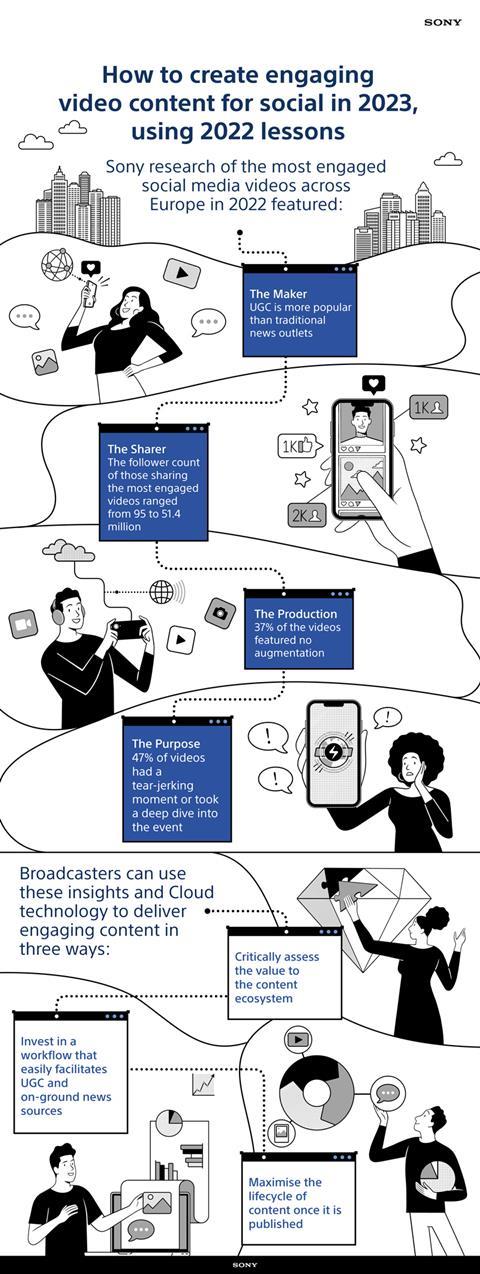Olivier Bovis, head of media solutions at Sony Europe argues broadcasters can glean important insights from how users engage with news content on social media and how cloud technology can assist

2022 was an extraordinary year of news. The war in Ukraine, death of Queen Elizabeth II and the defamation trial between Johnny Depp and Amber Heard are just some of the seismic events that gripped audiences throughout Europe, with many using Twitter as their primary source to stay in the loop.
Since its inception in 2006, the platform has been, and continues to be, fraught with controversies but has undeniably brought about fundamental change in how people consume news. It has created an expectation among audiences that they can be kept updated and engage with breaking news in real time.

Twitter released data showing just how many people come to the site for news: 94% of people on Twitter express an interest in current events, whilst 85% of users say they use the platform to watch, read, or listen to the news at least once a day.
The platform has therefore established itself as an essential channel of communication for broadcasters and production companies looking to source information and to get in front of their target audience, despite the headlines it has been generating.
How did Twitter users engage with the year’s biggest stories?
To take a closer look at how users engage with short-form content, Sony conducted in-depth analysis of the most engaged news stories on Twitter across Europe in 2022 that featured video content.
The content covered eight European countries, amounting to 201 million views and over 8.6 million points of engagement (termed as likes, retweets and comments). By assessing metrics such as augmentation, the average follower count of video sharers, and the proportion of User Generated Content (UGC), Sony hypothesized a series of key traits that form the ingredients of highly engaging content. These have since been applied to the capabilities of Cloud technology, which can play a major role in helping broadcasters to emulate these traits in the future.
The major findings were as follows:
• Quick access to credible video content. Perhaps the minimum requirement in the Twitter age, but notably a higher proportion of the most engaged videos came from UGC (39%) as opposed to content produced by traditional news outlets (30%).
• A demand for the unfiltered. Users want to see and judge for themselves the storylines unfolding in front of them. 37% of the most popular videos were ‘un-augmented’, in other words, there was no editing of the video footage before it is uploaded to the platform.
• Emotive storytelling. Almost half (47%) of videos with high engagement had one or more of the following criteria in common: tear-jerking moments, a critical deep dive into a specific news event, in terms of what was said and by who, or making sense of events through singular and relatable perspectives from people.
Broadcasters and media companies still play a critical role as guardians of high-quality, credentialled content, but to give audiences the range and depth they’re looking for, it must be sourced and delivered in a flexible, agile and seamless way.
This is where they can turn to Cloud technology. Whilst its use is growing, there remains huge scope for further utilisation, particularly for content that may be consumed across different platforms with slight tweaks to the formats. At its core, cloud or hybrid production and multi-format delivery allows broadcasters to securely bring added value to content by delivering content from anywhere to everywhere to existing and new demographics.
Three ways Cloud technology can deliver in the age of immediate content.
There are three salient strategies for broadcasters and production companies to consider when recalibrating their content for multiple platforms:
1. Critically assess the value new content is bringing to the content ecosystem. Whether it’s the access, the ability to provide quality live or archival footage, or aggregating human stories from multiple sources, it needs to have a clear point of difference to gain traction in the highly competitive landscape. Cloud technologies create new content value, powered by AI, that can acquire new audiences across social media.
2. Invest in a workflow that speeds up acquisition and re-imbursement of UGC and on-the-ground news sources. This enables broadcasters and production companies to tell stories from multiple perspectives with maximum agility. Cloud-based offerings allow broadcasters to better compete with UGC by transfer camera clips from the field to the cloud using just a smartphone. Production teams can then remotely view and pull content directly from cameras, even as they continue recordings.
3. Maximise the lifecycle of content once it is published. Broadcasters and production companies should make sure they are easily allowing audiences to find, reuse and repurpose material whilst it is related to a popular and newsworthy topic. To achieve this, production workflows can be created and configured to build smart, resilient production systems that work for the broadcaster, and by extension, the viewer.
Broadcasters who adopt even one of these activations in their content production will be well placed to not just retain their existing audiences, but also acquire new users who actively engage with their content. Perhaps more importantly, these technologies can, of course, be implemented across other social platforms and broadcast mediums.

Olivier Bovis is head of media Solutions at Sony Europe

































No comments yet